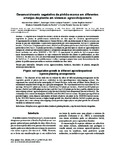Please use this identifier to cite or link to this item:
http://www.alice.cnptia.embrapa.br/alice/handle/doc/1014039| Title: | Desenvolvimento vegetativo de pinhão-manso em diferentes arranjos de plantio em sistemas agrossilvipastoris. |
| Authors: | MULLER, M. D.  PACIULLO, D. S. C.   MARTINS, C. E.   ROCHA, W. S. D. da   CASTRO, C. R. T. de   |
| Affiliation: | MARCELO DIAS MULLER, CNPGL; DOMINGOS SAVIO CAMPOS PACIULLO, CNPGL; CARLOS EUGENIO MARTINS, CNPGL; WADSON SEBASTIAO DUARTE DA ROCHA, CNPGL; CARLOS RENATO TAVARES DE CASTRO, CNPGL. |
| Date Issued: | 2014 |
| Citation: | Pesquisa Agropecuária Brasileira, Brasília, DF, v. 49, n. 7, p. 506-514, 2014. |
| Description: | RESUMO - O objetivo deste trabalho foi avaliar o efeito de diferentes arranjos de plantio no desenvolvimento vegetativo de plantas de pinhão?manso estabelecidas em dois tipos de consórcio agrossilvipastoril. O experimento foi realizado no Município de Coronel Pacheco, MG, em delineamento de blocos ao acaso, em arranjo de parcelas subdivididas. A parcela foi representada por cinco espaçamentos: 6x3m (555 plantas por hectare), 12x(2x2)m (714 plantas por Hectare), 10x(2x2)m (833 plantas por hectare), 8x(2x2)m (1.000 plantas por hectare) e 6x1,5 m (1.111 plantas por hectare); e a subparcela, por dois tipos de consórcio: agrossilvipastoril (integração lavoura?pecuária?pinhão?manso) e silvipastoril (integração pecuária?pinhão?manso). As avalições foram realizadas nas safras 2010/2011 e 2011/2012. O espaçamento de plantio de 6x3m proporcionou maior desenvolvimento em diâmetro de copa e número de brotações das plantas de pinhão?manso, na safra 2010/2011. Na safra 2011/2012, foi observado maior desenvolvimento em altura com o espaçamento de plantio de 8x(2x2) m. O consórcio de pinhão?manso x milho x pastagem proporciona maior desenvolvimento das plantas de pinhão-manso para todas as variáveis estudadas nas duas safra. ABSTRACT - The objective of this work was to evaluate the effect of different planting arrangements on the vegetative growth of physic nut trees established in two agrosilvopastoral intercropping systems. The experiment was carried out in the municipality of Coronel Pacheco, in the state of Minas Gerais, Brazil, in a randomized complete block design, in a split-plot arrangement. The experimental unit was represented by five spacings: 6x3 m (555 plants per hectare), 12x(2x2) m (714 plants per hectare), 10x(2x2) m (833 plants per hectare), 8x(2x2) m (1,000 plants per hectare), and 6x1.5 m (1,111 plants per hectare); and the subplot, by two intercropping systems: agrossilvopastoral (crop-livestock-forestry) and silvopastoral (livestock-forestry). The evaluations were carried out during the 2010/2011 and 2011/2012 harvest seasons. The plant spacing of 6x3 m provided higher crown diameter and number of shoots of physic nut plants in the 2010/2011 harvest season. In the 2011/2012 harvest season, a higher height growth was observed with the 8x(2x2) m plant spacing. The physic nut x corn x forage intercropping system provides higher physic nut plant growth for all studied variables in both harvest seasons. |
| Thesagro: | Agrossilvicultura Densidade de plantio Jatropha curcas |
| NAL Thesaurus: | biodiesel |
| Keywords: | Crop-livestock-forestry integration Integração lavoura-pecuária-floresta Planting densities |
| DOI: | https://doi.org/10.1590/S0100-204X2014000700002 |
| Type of Material: | Artigo de periódico |
| Access: | openAccess |
| Appears in Collections: | Artigo em periódico indexado (CNPGL)  |
Files in This Item:
| File | Description | Size | Format | |
|---|---|---|---|---|
| Cnpgl2014PesqAgrBrasDesenvolvimento.pdf | 3,3 MB | Adobe PDF |  View/Open |









